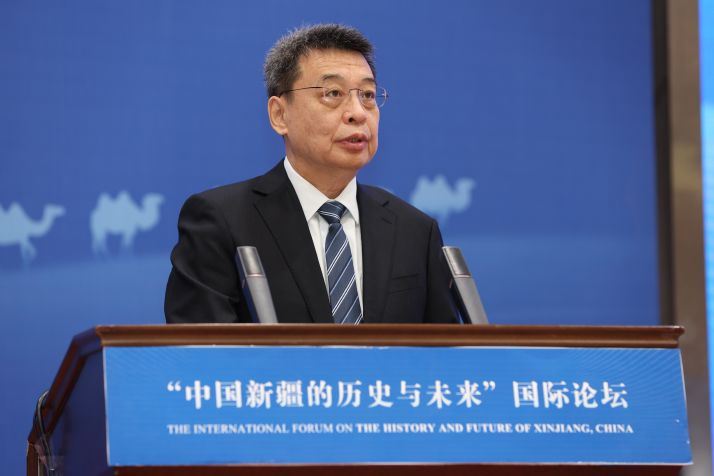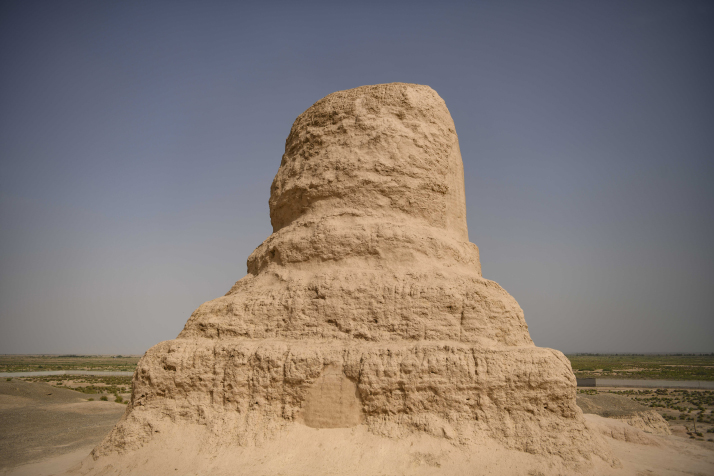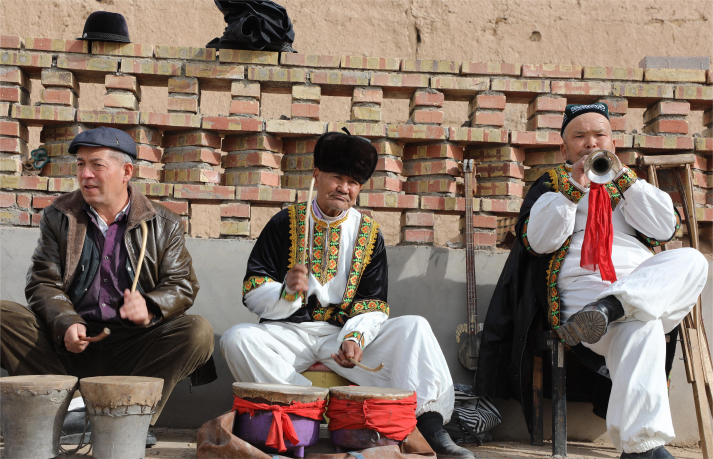| China |
| Unity in diversity | |
|
|
 Pan Yue
In his keynote speech at the opening ceremony of the International Forum on the History and Future of Xinjiang, China, Pan Yue, head of the National Ethnic Affairs Commission, underlined the importance of understanding Xinjiang Uygur Autonomous Region in the broader context of Chinese culture. Edited excerpts of his remarks follow: Xinjiang boasts a rich tradition and coexistence of diverse cultures and religions. In addition to numerous Buddhist sites, a Zoroastrian fire altar from 2,500 years ago was found in Tashkurgan County. In the ancient city of Milan in Ruoqiang County, a Greek-style "winged angel" Buddhist mural from 1,800 years ago was uncovered. Taoist scriptures and the Christian Bible were unearthed together from a 1,300-year-old Nestorian monastery in Turpan. Manichaean worship scenes from 1,000 years ago were discovered in the murals of the ancient city of Gaochang in Turpan. In the Tang Dynasty (618-907) city known as Dun, now in Qitai County, a Nestorian church from 1,200 year ago was found, whose murals depict the scene of Jesus entering Jerusalem on a donkey. Inside the city, an ancient Roman-style bathhouse from 1,000 years ago was also excavated. These ancient cultures, together with Islamic culture later, have merged into the rich religious culture of Xinjiang. The culture of Xinjiang is diverse but united. That unifying element is Chinese culture.  The ruins of a Buddhist temple in Kashgar, Xinjiang Uygur Autonomous Region, on June 12, 2023 (XINHUA)
Internationally, there is a baseless narrative that separates Xinjiang culture and Chinese culture and even portrays them as being in opposition. However, a large amount of archaeological evidence tells us that Xinjiang has always been an important part of the Chinese cultural sphere. During the Neolithic period, the painted pottery culture from the Yellow River Basin had already spread to the northern and southern regions of the Tianshan Mountains through what are today Gansu and Qinghai provinces. Jade is a unique Chinese cultural symbol, representing national power and ritual ceremonies, and Hotan jade from Xinjiang has been found at cultural sites in Yangshao, Longshan, Qijia, Yinxu and other places in the Central Plains. Before the Han Dynasty (206 B.C.-A.D. 220) exercised jurisdiction over Xinjiang 2,000 years ago, the legend of the Queen Mother of the West of the Kunlun Mountain in Xinjiang had long been a core part of the Chinese mythological system. Moreover, the large quantities of Confucian cultural relics unearthed in places in Xinjiang from the Han, Jin (265-420), Southern and Northern (420-589), Tang, Song (960-1279) and Yuan (1279-1368) dynasties, such as the ancient city of Loulan in south Xinjiang, the Niya site on the southern edge of the Tarim Basin, and the Astana tombs in Turpan, including remnants of Confucian classics like the Book of Songs, the Book of Documents, the Spring and Autumn Annals, Zuo Zhuan, the Analects, the Book of Rites, and the Classic of Filial Piety, all reflect the historical fact that Chinese culture has flourished in Xinjiang. The previously mentioned diverse cultures, introduced from all directions and able to develop here, further testify to the inclusiveness of Chinese culture from another perspective. Confucian culture is humanistic rather than religious, without exclusivity, and can accommodate the coexistence and development of multiple religions. The more inclusive and open it is, the more it is recognized, cherished and maintained by all parties, ensuring the continuous and unbroken heritage of Chinese civilization to this day. There is an internationally prevalent narrative that untruthfully portrays the relationship between Xinjiang culture and Chinese culture as being the "assimilation" of the former by the latter. This reflects the widespread ignorance of Chinese history. Peoples of the Western Regions have always been co-creators of Chinese culture. Chinese culture and the Chinese nation have been continuously inherited and developed over generations. The foundation of a cultural community is the deep integration of the economy and society. Over several thousand years, people from all directions and ethnic groups migrated, settled, traded and intermarried, and formed a coexistence pattern in Xinjiang. Ultimately, Xinjiang and the Central Plains belonged to the same political community, which was the inevitable result of the development of economic, social and cultural communities. Some foreign friends are concerned that if Xinjiang is considered an integral part of Chinese civilization, it might lose its cultural identity. According to Western pluralism, diversity and unity are often seen as contradictory. However, Chinese philosophy always unifies diversity and unity, even merging seemingly contradictory elements, such as the integration between Confucianism, Buddhism and Taoism. Today, Confucianism, Buddhism and Taoism have not merged into a single entity. Instead, they have intermingled, creating a broader intellectual community for the Chinese people, one that embodies unity in diversity. Islam entered China with a similar experience. One route was through the Maritime Silk Road to Quanzhou in today's Fujian Province, the other was through the Overland Silk Road to Xinjiang and its entry led to religious conflicts with the local faith of Buddhism. Many traces of this part of history can be found in Buddhist ruins in south Xinjiang. However, ultimately, Islam, after its entry into China, began integrating with Confucian, Taoist and even Buddhist philosophies during the late Ming (1368-1644) and early Qing (1644-1911) dynasties. This resulted in a distinct body of thought on the integration of Islam and Confucianism, the spirit of which continues to nourish Xinjiang today.  Musicians perform in Kuqa, Xinjiang, on March 15. Kuqa, known as Qiuci in ancient times, was a political, economic and cultural center in the Western Regions during the Han (206 B.C.-A.D. 220) and Tang (618-907) dynasties (XINHUA)
Upon entering China, both Buddhism and Islam underwent collisions and integrations, evolving into Sinicized Buddhism and Sinicized Islam. This process of collision and integration was not aimed at eliminating each other but at enhancing each other, resulting in the emergence of more inclusive civilizations. The story of Xinjiang demonstrates how Chinese civilization has always remained vibrant through its inclusiveness. All politicians and scholars around the world who are interested in China should study President Xi Jinping's concept of the "second integration"—the integration of Marxism with China's excellent traditional culture. This integration has produced a profound "chemical reaction," creating a new, organically unified cultural entity. The integration of Marxism with the continuity of the Chinese civilization fundamentally determines that the Chinese path contains an uninterrupted civilizational logic. The integration of Marxism with the innovative nature of Chinese civilization determines that this "integration" is not about reviving the past but about ushering in a new ideological liberation. The integration of Marxism with the unity of Chinese civilization determines that the country's territory cannot be separated, its stability cannot be disrupted, the nation cannot be divided, and the civilization cannot be interrupted. The integration of Marxism with the inclusiveness of Chinese civilization determines that Chinese civilization has never sought to replace diverse cultures with a single one, but has instead formed a common culture through the convergence of multiple cultures. The integration of Marxism with the peaceful nature of Chinese civilization determines that the Chinese civilization in modern times always strives for harmonious coexistence, consistently seeking common ground while reserving differences, and continually pursuing peaceful and mutually beneficial outcomes. The stories of the peaceful coexistence of multiple ethnic groups and diverse religions in Xinjiang illustrate to the world that China, a country that has experienced almost no religious wars for thousands of years, and a country that has never engaged in colonial expansion or forced cultural exportation, may offer another perspective on ethnic and religious conflicts. As a place where diverse civilizations converge, research on the historical and future Xinjiang must adhere to the path of unity in diversity, building a safer and more harmonious Xinjiang. It will better serve as a hub connecting China with Central Asia, West Asia and Europe. It will play a stronger supporting role in creating the core area of the Belt and Road Initiative. It will also better protect the excellent cultures of ethnic groups to enrich and develop the splendid and diverse Chinese civilization. Therefore, Xinjiang is not only China's Xinjiang but also the world's Xinjiang. It is our shared vision to make Xinjiang, with its past, present and future, reach out to the world. BR Copyedited by G.P. Wilson Comments to yanwei@cicgamericas.com |
|
||||||||||||||||||||||||||||
|